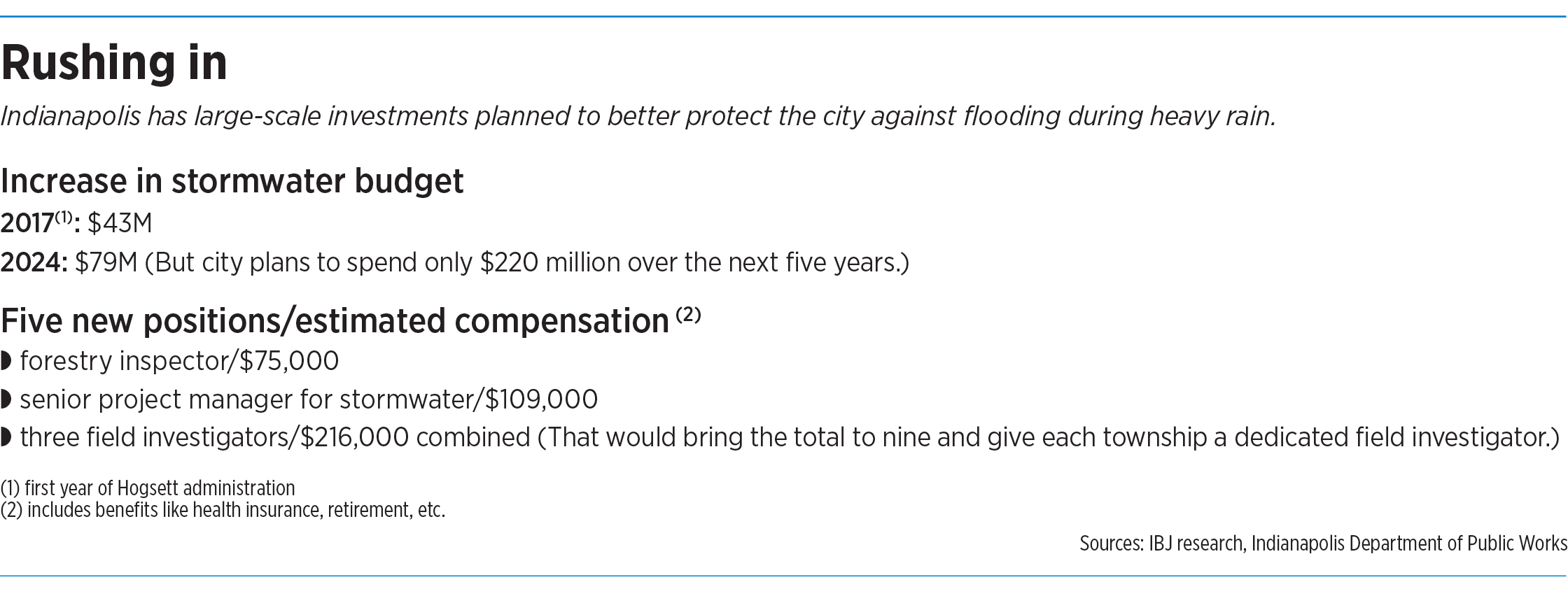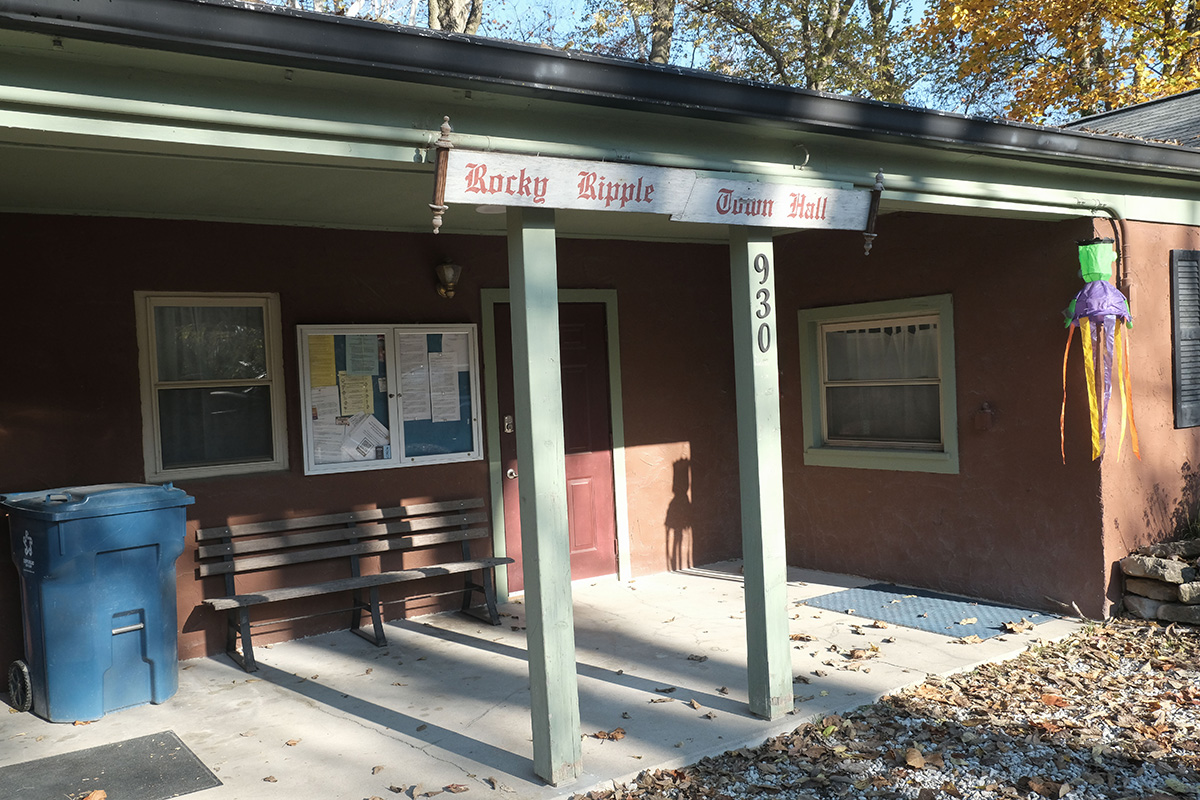Subscriber Benefit
As a subscriber you can listen to articles at work, in the car, or while you work out. Subscribe NowIndianapolis officials say they are preparing for more severe weather in the years to come as climate-change events threaten to overwhelm the stormwater drainage system and pose other problems.
“Whether it’s stormwater, whether it’s flash freezing, polar vortex situation in the winter, whether it’s high-wind events, and those surprise pop-up thunderstorms that we see over the summer, we need to become more climate-resilient as a city as we deal with the real-time impact of climate change,” said Brandon Herget, director of the city’s Department of Public Works.
To deal with the shifting weather and prepare Indianapolis’ aging infrastructure for any onslaught, the city is devoting more people and more resources to the cause.
The 2024 budget includes funding for five additional climate-related employees—amounting to about $400,000 a year, including benefits.
The positions include a senior project manager for stormwater, a forestry inspector to identify trees that might threaten public safety and three additional field investigators to help identify and monitor problems with stormwater infrastructure.
The Hogsett administration has gradually increased the Department of Public Works’ annual stormwater budget, from $43 million in 2017 to $79 million in 2024. But it is budgeted to spend only $220 million on stormwater improvements over the next five years, an annual average of $44 million.
 The city’s stormwater and sewer systems, built in the early 20th century, were designed for storm events that were less severe or less prolonged than today’s, said Brian Neilson, a senior project manager with HWC Engineering who works with the White River Alliance, a not-for-profit dedicated to improving and protecting central Indiana’s water resources.
The city’s stormwater and sewer systems, built in the early 20th century, were designed for storm events that were less severe or less prolonged than today’s, said Brian Neilson, a senior project manager with HWC Engineering who works with the White River Alliance, a not-for-profit dedicated to improving and protecting central Indiana’s water resources.
A water report from Purdue University’s Indiana Climate Change Impacts Assessment found that Indiana will see 6% to 8% more annual precipitation by midcentury under medium- to high-carbon emission scenarios.
Indianapolis hasn’t seen any drastic flooding recently, but other areas across the nation have. New York City experienced near-historic levels of flooding in October after a tropical storm lingered for 12 hours. Experts say the flooding was caused by a combination of a climate-change-fueled event and an inadequate drainage system plopped on top of what was originally creeks and marshes.
Shannon Killion, the city’s stormwater administrator, said Indianapolis has prioritized finding natural spaces to help collect excessive rainfall.
Projects like this are known as “green” stormwater projects. They mimic nature and are designed to capture rainwater where it falls, unlike “gray” projects that collect runoff from impervious surfaces like roofs and parking lots.
Neilsen, who called himself an advocate for green-stormwater infrastructure, said the method is often more cost-effective and Indianapolis is further along on usage of alternative stormwater methods than are some comparable cities.
The recently completed $16.5 million Keystone Avenue South Stormwater Outfall project includes bringing to the surface a creek at Washington Park that had been buried below ground. Killion said projects that unearth groundwater not only improve drainage but also help neighborhood residents appreciate the natural water that was once hidden.
The three new field investigators will help ensure that the department is properly maintaining stormwater infrastructure, she said. The addition of three positions will put the total at nine, allowing each field investigator to focus on a single township of Marion County.
“[They will] be out on our streets and identifying, ‘That looks different than yesterday,’” Killion said. “What can we proactively do to make the repair that’s needed or carry out that work so that when a storm event occurs, our systems are operating as [well] as they can?”
The stormwater projects will work in concert with extensive sewer-system upgrades led by Citizens Energy Group, the city’s utility provider.

Citizens is amid a monumental shift from a combined sewer system—which can send untreated wastewater into the White River in heavy rainfall—to a separated sewer system. The conduit for the change is mainly the company’s Dig Indy project.
The $2 billion, 20-year tunnel project began planning and design in 2006 and will total 28.6 miles. The final sections, the Fall Creek and Pleasant Run tunnels, are expected to wrap up construction late next year and in mid-2025, respectively.
The completed segments have prevented more than 4.5 billion gallons of sewage from entering central Indiana waterways, Citizens spokesman Ben Easley said in an emailed statement.
Flood protection also is a key component of climate-change improvements. But a long-planned new levee in Rocky Ripple is at a standstill, leaving residents and officials concerned about the impact of harsher weather events.
Randy Sanders, a Rocky Ripple town councilor, said the setback is concerning because the town’s existing floodwall, built in the 1930s, has been breached multiple times over the decades. A 2017 study from Los Angeles-based AECOM predicted a 92% chance that Rocky Ripple’s levee will fail at least once in the next 50 years.
“Quite honestly, with what we’re seeing in climate change and how some large rain events are happening more and more often, it’s a very big concern,” Sanders told IBJ.
Rocky Ripple is an incorporated town nestled in a crook of the White River between 51st and 54th streets, just west of the Central Canal and just north of Butler University; it covers less than a half square mile. Town support for the new levee is divided because the project requires the demolition of 14 homes and the historic town hall. But building a new levee was supported by a majority of Rocky Ripple voters in a 2018 referendum.
The project has been pushed to 2025 because the city has had difficulty gaining federal approval of an earlier flood-protection project it hopes to model the levee after.
The Rocky Ripple Flood Damage Reduction Project needs a conditional letter of map revision, which indicates whether a project will be recognized by the Federal Emergency Management Agency, Killion told IBJ. It does not guarantee a revision to floodplain maps.
Killion said the Department of Public Works is working with FEMA and the U.S. Army Corps of Engineers to secure the letter.

Margaret Brabant, a Rocky Ripple resident who would lose her garage and backyard under the current levee plan, called the prospect of destroying the current town hall a “breathtaking act of destruction.”
But Sanders said it’s a necessary move to protect the rest of the community. Plus, the city of Indianapolis would be on the hook to construct a new town hall for Rocky Ripple, he said.
“Sometimes those hard decisions have to be made, and we’ve got to do what’s best for the whole community,” Sanders said.
Killion said the city is applying for grants that would allow it to make improvements in other parts of the city and designate them as less flood-prone and outside the floodplain.
Among those areas is the Mars Hill neighborhood on the southwest side. A case study of that area proposes several improvements, including bank stabilization, that would mitigate the risk of flooding and remove 653 parcels from the 100-year floodplain.•
Please enable JavaScript to view this content.




All under the threat of climate change? That is a stretch. This proposed projects are needed to prevent sewage from dumping into the river when it rains and this problem has existed for 50+ years. And the other projects are to remove people from the 100 year flood zone, again not related to climate change.
I’m in favor of keeping our waterways clean, but let’s not hide behind the climate change cloud unless that is a requirement to secure federal funding.
Thank you. Anyone who has been around the metro area for decades knows this is growth and planning issues. Not “Climate Change”!
Keep your head in the sand, Scott and David. Believe what you, but I’ve lived in Indianapolis for 58 years and the climate here has most definitely changed. The real “breathtaking act of destruction” will be when Rocky Ripple becomes a bathtub following a prolonged severe storm event.
+1 “Climate change” is a politicized term that apparently even our bumbling mayor and his team now want to use to justify their existence. This is simply city planning.
All of the politically correct administration have their marching orders to continually spin the green propaganda. What a bunch of crap.
5 more worthless bureaucratic positions.
+1
What a total waste of taxpayers dollars! And you wonder why taxes will never ever go down when they can find the NEED for 5 people that will probably sit at their desk and shuffle papers. All in the name of the bogus threat of climate change! Bureaucracy at its best!